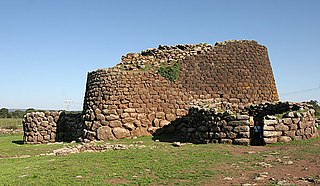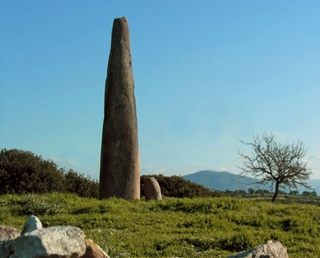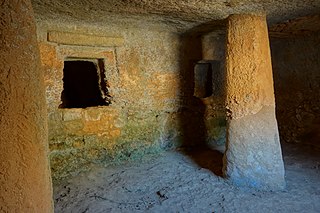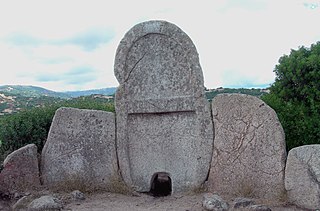
The nuraghe, or nurhag, is the main type of ancient megalithic edifice found in Sardinia, Italy, developed during the Nuragic Age between 1900 and 730 BC. Today it has come to be the symbol of Sardinia and its distinctive culture known as the Nuragic civilization. More than 7,000 nuraghes have been found, though archeologists believe that originally there were more than 10,000.

Gallura is a region in North-Eastern Sardinia, Italy.

A megalith is a large stone that has been used to construct a prehistoric structure or monument, either alone or together with other stones. There are over 35,000 structures or arrangements in Europe alone, located widely from Sweden to the Mediterranean sea.

Giants' grave is the name given by local people and archaeologists to a type of Sardinian megalithic gallery grave built during the Bronze Age by the Nuragic civilization. They were collective tombs and can be found throughout Sardinia, with 800 being discovered there.
This article describes several characteristic architectural elements typical of European megalithic structures.

The Nuragic civilization, also known as the Nuragic culture, formed in the Mediterranean island of Sardinia, Italy in the Bronze Age. According to the traditional theory put forward by Giovanni Lilliu in 1966, it developed after multiple migrations from the West of people related to the Beaker culture who conquered and disrupted the local Copper Age cultures; other scholars instead hypothesize an autochthonous origin. It lasted from the 18th century BC, up to the Iron Age or till the Roman colonization in 238 BC. Others date the culture as lasting at least until the 2nd century AD, and in some areas, namely the Barbagia, to the 6th century AD, or possibly even to the 11th century AD. Although it must be remarked that the construction of new nuraghi had already stopped by the 12th-11th century BC, during the Final Bronze Age.

Monte d'Accoddi is a Neolithic archaeological site in northern Sardinia, located in the territory of Sassari, Italy. The site consists of a massive raised stone platform thought to have been an altar. It was constructed by the Ozieri culture or earlier, with the oldest parts dated to around 4,000–3,650 BC.
The Ozieri culture was a prehistoric pre-Nuragic culture that occupied Sardinia from c. 3200 to 2800 BCE. The Ozieri was the culmination of the island's Neolithic culture and takes its name from the locality where early findings connected with it have been found, the cave of San Michele near Ozieri, in northern Sardinia. The Ozieri existed contemporaneously with the Arzachena culture, sharing some similarities, and its influence also extended to nearby Corsica.

The Giants of Mont'e Prama are ancient stone sculptures created by the Nuragic civilization of Sardinia, Italy. Fragmented into numerous pieces, they were discovered in March 1974 on farmland near Mont'e Prama, in the comune of Cabras, province of Oristano, in central-western Sardinia. The statues are carved in local sandstone and their height varies between 2 and 2.5 meters.

The Nuraghe La Prisgiona is a nuragic archaeological site, located in the Capichera valley in the municipality of Arzachena Costa Smeralda in the north of Sardinia. It consists of a nuraghe and a village comprising around 90–100 buildings, spread across 5 hectares. Findings from this site are in many cases unique in Sardinia, particularly with regard to decoration and use. Due to the large extent and number of buildings the site is considered unique in North-East Sardinia. There is also some evidence for occupation during Roman and medieval times. The Giants' grave Coddu Vecchiu is located nearby.

The Arzachena culture was a pre-Nuragic culture of the Late Neolithic Age occupying Gallura and part of southern Corsica from approximately the 4th to the 3rd millennium BC. It takes its name from the Sardinian town of Arzachena.

The Pre-Nuragic period refers to the prehistory of Sardinia from the Paleolithic until the middle Bronze Age, when the Nuragic civilization flourished on the island.

The necropolis of Anghelu Ruju is a pre-Nuragic archaeological site located north of the city of Alghero, Province of Sassari, Sardinia. It is the largest necropolis of pre-Nuragic Sardinia.

The Necropolis of Li Muri is an archaeological site located in the municipality of Arzachena, Sardinia.

The giants' grave of S'Ena'e Thomes is a nuragic-era archaeological site located in the municipality of Dorgali, in the province of Nuoro, Sardinia.

The giants' grave of Is Concias is an archaeological site of Quartucciu, municipality of the metropolitan City of Cagliari.

The Giants' grave of Su Mont'e s'Abe is an archaeological site located in the municipality of Olbia, in the Italian province of Sassari.

The Civic Archaeological Museum "Alle Clarisse" of Ozieri is one of the most important museums in Northern Sardinia. Since 2003 it has been transferred to the former Poor Clares' convent. Its showcases contain the most significant finds found in the municipal area of Ozieri: the materials on display date from prehistoric times to the Modern Age.

The Menhir Museum, or Civic Archaeological Museum of the Menhir Statues, located in the Aymerich Palace in the village of Laconi, is a unique museum of its kind for its rich collection of steles found in the Laconi area, with the first discovery in 1969.
























